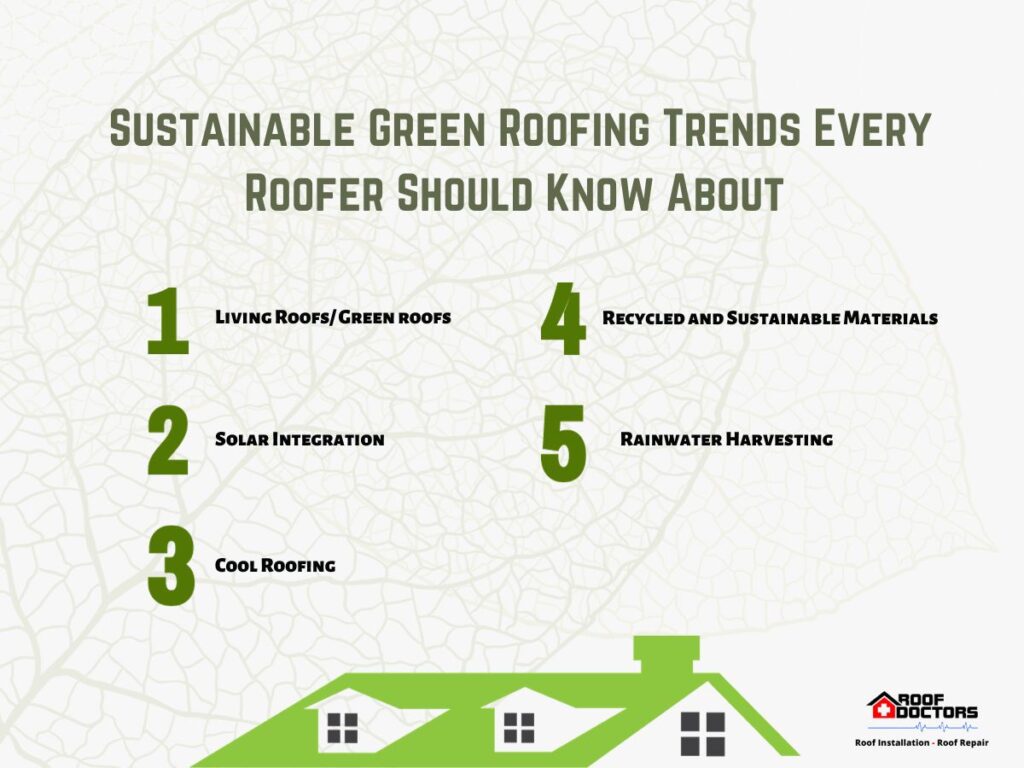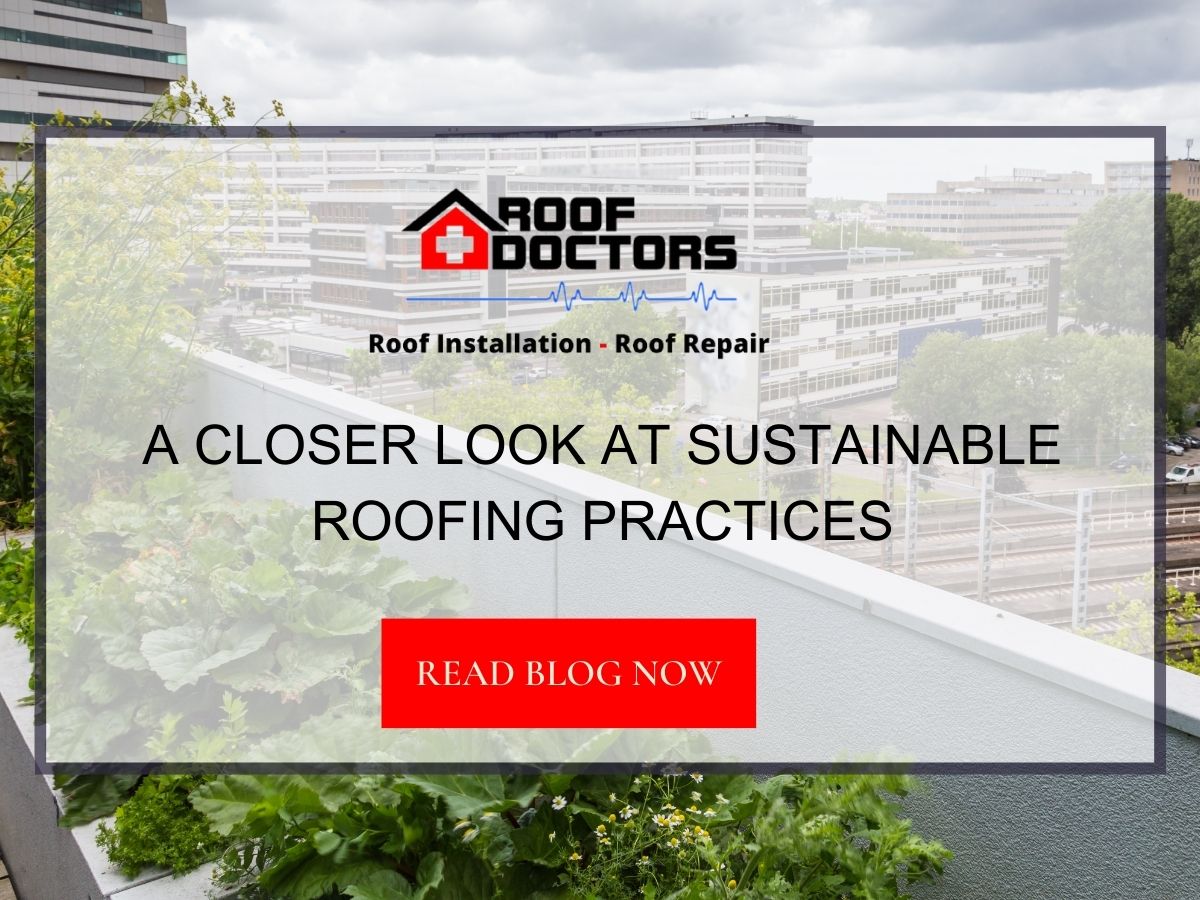Why should we take a closer look at sustainable roofing practices? In recent years, sustainable roofing practices have gained significant attention as the construction industry seeks to reduce its environmental impact.
From green roofs that enhance biodiversity to using recycled materials, sustainable roofing offers a promising solution for addressing climate change and resource conservation. Let’s first define what makes roofing sustainable.
What Makes Roofing Sustainable?
Sustainable roofing incorporates environmentally friendly materials, energy-efficient designs, and proper insulation to minimize resource consumption and reduce waste.
It focuses on durability, longevity, and recyclability while also considering the impact on the surrounding environment. Proper installation and maintenance further enhance the sustainability of roofing systems.
Comparing Roofing Material Sustainability

When it comes to roofing, sustainability has become an increasingly important consideration for homeowners and businesses alike. With a growing emphasis on environmental consciousness, it’s crucial to understand the sustainability factors associated with different roofing materials. Below are some of the roofing materials:

Metal Roofing
Metal roofing uses a lot of energy to manufacture, but the material is beautiful, lasts a long time, and can be recycled once its intended lifespan ends. They can reduce heat intake by reflecting some of the sun’s rays, but they still need adequate insulation to prevent heat transfer.
Steel and aluminum are the most popular metal roofing options. Since metals require resources mined from the earth, they cannot be considered environmentally friendly.
Slate Roofing
Slate is stunning , sustainable and highly long-lasting (a slate roof can outlast the home), but it is also quite costly, hard to work with, and requires a lot of energy to transport. The northeastern states produce the majority of the country’s slate.
The extraction of stones is not a sustainable industry. Slate roofs are heavy; thus, they require more support beams than those used for roofs made of lighter materials.
Tile Roofing
Tile roofing, known for its aesthetic appeal and durability, can outlive many structures. However, the energy-intensive transportation and production processes contribute to its carbon footprint.
Additionally, heavy tiles demand extra support beams, adding to material requirements. Other sustainable alternatives must be explored to reduce environmental impact and ensure a greener future.
Wood Shakes and Shingles roofing
Wood is a renewable resource; wood shakes and shingles are among the most eco-friendly roof options. Assuming, of course, that the roofing materials are gathered in an environmentally friendly way.
Shakes and shingles require a lot of energy, and the finished product is only somewhat durable, especially when compared to slate and clay tile. Roofs made of untreated timber biodegrade without difficulty because they contain no synthetic additives or preservatives, making for simple disposal.
If you reside in a region that produces shakes locally or have access to shingles manufactured from FSC-certified wood, opting for a wood roof may be an extremely eco-friendly option.
Asphalt Shingles
Standard asphalt shingles, also known as composite shingles, have a modest lifespan and can be an excellent heat reflector depending on the shingle’s color and pattern. Materials such as fiberglass, tar, and other petroleum byproducts are combined with paper and minerals to create these.
Asphalt shingles are rarely recycled. They are not biodegradable, but some businesses and communities find uses for them anyhow. They are not environmentally friendly because they are made from petroleum.
Sustainable Green Roofing Trends Every Roofer Should Know About

As the world continues to prioritize environmental sustainability, the construction industry is also evolving to meet these demands. Roofing, in particular, has seen a surge in sustainable practices, with green roofing becoming an increasingly popular choice for eco-conscious homeowners and businesses.
Green roofs are some of the best roof types in California. Below we will explore some of the latest sustainable green roofing trends that every roofer should know about.

Living Roofs/ Green roofs
They are also known as green roofs, are one of the most prominent trends in sustainable roofing. These roofs are covered with a layer of vegetation, creating a natural habitat and providing numerous environmental benefits.
Living roofs help improve air quality, reduce stormwater runoff, and provide insulation, resulting in energy savings. They also enhance the aesthetic appeal of buildings and contribute to urban biodiversity.
As a roofer, it’s crucial to familiarize yourself with the installation and maintenance requirements of living roofs to cater to the growing demand.
Solar Integration
Solar power is a clean and renewable energy source gaining popularity worldwide. Integrating solar panels with roofing systems has become a significant trend in sustainable construction. Solar shingles and panels can be seamlessly integrated into roofing materials, providing homeowners with an eco-friendly energy solution.
As a roofer, understanding the intricacies of solar integration and collaborating with solar installers can open up new business opportunities and allow you to offer comprehensive sustainable roofing solutions.
Cool Roofing
It is designed to reflect sunlight and absorb less heat than traditional roofing materials. These roofs are typically made with reflective materials or coatings that minimize heat absorption, reducing the cooling needs of buildings.
Cool roofs contribute to energy efficiency, as they help lower indoor temperatures, reduce air conditioning costs, and alleviate the urban heat island effect. Staying updated on the latest cool roofing technologies and installation techniques will position you as a knowledgeable and sustainable roofer.
Recycled and Sustainable Materials
In line with the growing focus on sustainability, using recycled and sustainable materials in roofing construction is gaining momentum. Recycled shingles, tiles, and metal roofing made from reclaimed materials are becoming more widely available.
Additionally, sustainable alternatives like bamboo, cork, and reclaimed wood are being used for roofing purposes. By incorporating these materials into your roofing projects, you can help reduce the environmental impact of construction and appeal to environmentally conscious clients.
Rainwater Harvesting
Water scarcity is a pressing issue in many parts of the world, making rainwater harvesting systems an essential trend in sustainable roofing.
These systems collect and store rainwater runoff from the roof, which can then be used for various purposes such as irrigation, flushing toilets, or even drinking water with proper filtration. As a roofer, understanding the design and installation requirements of rainwater harvesting systems can provide added value to your clients and contribute to water conservation efforts.
Benefits of Using Sustainable Roofing Materials & Products

Changing the roof’s design or replacing its materials can have a significant impact on the building’s environmental friendliness. Research shows that, on average, a building will lose 25% of its heat through the roof.
Green roofing materials and “cool roofs” that reflect the sun’s rays have the potential to boost the energy efficiency of our buildings significantly.Let’s take a closer look at how eco-friendly roofing benefits property owners.

Reductions in Taxes
Currently, the federal government provides substantial tax credits for installing renewable energy products (such as solar panels and geothermal heat pumps) and constructing energy-efficient homes and commercial buildings.
In addition to federal tax credits, many states and municipalities have their own financial incentives for building with eco-friendly, energy-saving products. Search online to learn more about the tax breaks available in your area.
Reduced Lifecycle Costs
The annual cost of maintaining your roof over its expected lifespan is known as the lifetime cost of your roofing system. It factors in the price of the roof itself throughout its expected lifespan, the cost of repair and maintenance, and the cost of running the building itself (heating, cooling, etc.).
Although green roofing materials may cost more initially, they often last longer, according to research. Sustainable roofing materials may have lower total lifecycle costs due to reduced operating costs.
Increased Commercial Rental Income
Tenants are becoming increasingly interested in environmentally friendly buildings, meaning owners may charge higher rents and experience less loss in property value.
The long-term benefits of sustainable materials are readily apparent to forward-thinking investors and building owners.
Challenges of “Going Green”
The green building movement is only getting started. Moving toward “going green” still creates obstacles for architects, investors, and building owners, but no more so than any other growing technology.
Let’s look into a few of these concerns.
High Costs and Economic Viability
Embracing sustainable technologies and practices often comes with a higher upfront cost. Renewable energy systems, energy-efficient appliances, and eco-friendly materials may require substantial investments.
For individuals and businesses, the economic viability of going green can pose a significant challenge, especially in regions where fossil fuel-based alternatives are more affordable.
Infrastructural Limitations
Achieving widespread sustainability often requires significant infrastructural changes. Building the necessary infrastructure for renewable energy generation, electric vehicle charging stations, and waste management systems can be daunting.
Moreover, existing infrastructures designed for conventional practices may need to be compatible with sustainable alternatives, further hindering progress.
Tips for maintaining a sustainable roof

A sustainable roof is not only good for the environment but also for your wallet. You can extend its lifespan by implementing eco-friendly practices and maintaining your roof effectively while reducing energy consumption.
We will now explore essential tips for maintaining a sustainable roof that ensures durability and eco-consciousness:
- Optimal Insulation – Proper insulation is crucial for energy efficiency. Ensure your roof is well-insulated to minimize heat transfer, preventing excessive energy consumption for heating and cooling. Use materials like spray foam insulation or eco-friendly options like cellulose or recycled denim.
- Regular Roof Inspections – Schedule periodic inspections to identify any signs of damage, leaks, or wear and tear. Early detection and timely repairs can prevent minor issues from turning into major problems, reducing the need for extensive repairs or roof replacement.
- Rainwater Harvesting – Consider installing a rainwater harvesting system on your roof. By collecting rainwater, you can utilize it for various purposes like watering plants, washing cars, or even flushing toilets. This practice reduces water consumption and lessens the strain on local water resources.
- Green Roofing – Implementing green roofing solutions not only enhances the aesthetic appeal of your home but also provides environmental benefits. Green roofs involve adding vegetation, which improves insulation, reduces stormwater runoff, mitigates urban heat island effect, and increases biodiversity.
- Proper Ventilation – Ensure your roof has adequate ventilation to minimize moisture buildup and reduce the risk of mold and mildew growth. Proper ventilation helps regulate indoor temperature, reducing the need for excessive air conditioning and saving energy.
- Sustainable Roofing Materials – When it’s time for roof replacement, choose sustainable materials such as metal, clay tiles, or recycled shingles. These options are durable, recyclable, and often energy-efficient. They reduce the demand for new materials and promote a circular economy.
- Solar Panels – Consider installing solar panels on your roof to harness the sun’s power and generate clean energy for your home. Solar panels reduce your carbon footprint and help save on electricity bills in the long run.
Conclusion
At Roof Doctors, we believe in the power of sustainable roofing practices. By implementing regular inspections, promoting eco-friendly materials, and investing in professional maintenance, you can ensure a longer-lasting roof while reducing your environmental footprint. Need roof repair or replacement? Trust us to provide the expertise and care your roof deserves. Contact us today for a greener future.


